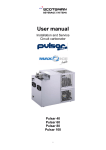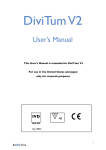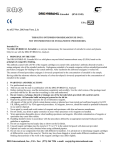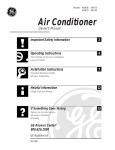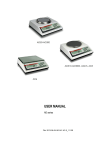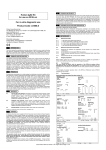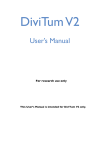Download Change to insert re sensitivity added EFG (Sect 1)
Transcript
7 MININEPH™ IgG LOW LEVEL KIT For In-vitro Research Use Product Code: ZK004.LL Product manufactured by: The Binding Site Group Ltd, 8 Calthorpe Road, Edgbaston, Birmingham, B15 1QT , UK www.bindingsite.co.uk Telephone: +44 (0)121 456 9500 Fax: +44 (0)121 456 9749 e-mail: [email protected] MININEPH™ and MININEPHPLUS™ are trademarks of The Binding Site Group Ltd., Birmingham, UK 1 INTENDED USE This kit is designed for the In Vitro measurement of IgG at low levels using the MININEPHTM or MININEPHPLUS*. When using neat sample, the approximate measuring range is 10.5 – 168mg/L. The assay is for Research use only - it is the responsibility of the user to validate the assay and ensure that it is fit for purpose. *The MININEPHPLUS analyser is not available in the USA. 2 3.1 3.2 3.3 3.4 4 7.1 MATERIALS PROVIDED 7.1.1 7.1.2 7.1.3 7.1.4 7.1.5 7.1.6 1 x 2 mL MININEPH Human IgG Low Level Reagent 1 x 25 mL MININEPH IgG Low Level Buffer 1 x 0.5 mL MININEPH Human IgG Low Level Control Magnetic swipe card containing lot specific calibration information Quality Control Certificate Instruction leaflet 7.2 MATERIALS REQUIRED BUT NOT PROVIDED (MININEPH) 7.2.1 7.2.2 7.2.3 7.2.4 7.2.5 7.2.6 MININEPH instrument (AD200) MININEPH printer (AD210) (optional) MININEPH reagent accessory pack (ZK500.R) Electronic pipette (e.g. AD205) Pipette (5 – 40L) Equipment for the collection and preparation of test samples 7.3 MATERIALS REQUIRED BUT NOT PROVIDED (MININEPHPLUS) 7.3.1 7.3.2 7.3.3 7.3.4 7.3.5 7.3.6 7.3.7 7.3.8 MININEPHPLUS instrument (AD500 .C/D/E) MININEPHPLUS PRINTER (AP1310DPK1T63) (optional) Bar Code Reader (optional) MININEPH reagent accessory pack (ZK500.R) Pipette (5-1000L) Equipment for the collection and preparation of test samples MININEPHPLUS On-Board Buffer 1 (SN107) Pipette tips for use with the MININEPHPLUS – refer to MININEPHPLUS User Guide. 7.4 TEST PROCEDURE – MININEPH ANALYSER 7.4.1 Summary of reagent volumes added to the cuvette: Reagent Sample (Undiluted) MININEPH IgG Low Level Buffer MININEPH Hu IgG Low Level Reagent PRINCIPLE OF THE ASSAY The determination of soluble antigen concentration by nephelometric methods involves a reaction with the antibody to form insoluble complexes. When light is passed through the suspension formed, a portion of the light is scattered and detected by a photodiode. The amount of light scattered is directly proportional to the specific protein concentration in the test sample. Concentrations are automatically calculated by reference to a calibration curve stored within the instrument. 3 7.4.2 7.4.3 7.4.4 REAGENTS 7.4.5 7.4.6 MININEPH HUMAN IgG LOW LEVEL REAGENT This has been adsorbed to monospecificity for IgG and is supplied in stabilised liquid form. It contains 0.099% sodium azide, 0.1% EACA and 0.01% benzamidine as preservatives. MININEPH IgG LOW LEVEL SWIPE CARD This is encoded with details of the reaction curve specific to the respective lot of reagent. This card is lot specific and must be used only with this lot of reagent. The curve on this card has been prepared using secondary calibration materials that have been calibrated against CRM470. MININEPH IgG LOW LEVEL BUFFER For use with this lot of IgG Low Level reagent only. Contains 0.099% sodium azide as a preservative. MININEPH HUMAN IgG LOW LEVEL CONTROL This consists of pooled normal human serum and is supplied in stabilised liquid form. It contains 0.099% sodium azide, 0.1% EACA and 0.01% benzamidine as preservatives. The acceptable range of IgG concentrations are stated on the Quality Control Certificate included in the kit. The lot number quoted on the Quality Control Certificate should be identical to the kit lot number. 7.4.7 7.4.8 7.4.9 7.4.10 7.4.11 CAUTION All donors of human serum supplied in this kit have been serum tested and found negative for hepatitis B surface antigen (HBsAg) and antibodies to human immunodeficiency virus (HIV1 and HIV2) and hepatitis C virus. The assays used were either approved by the FDA (USA) or cleared for in vitro diagnostic use in the EU (Directive 98/79/EC, Annex II); however, these tests cannot guarantee the absence of infective agents. Proper handling and disposal methods should be established as for all potentially infective material, including (but not limited to) users wearing suitable protective equipment and clothing at all times. Only personnel fully trained in such methods should be permitted to perform these procedures. 7.4.12 WARNING: This product contains sodium azide and must be handled with caution; suitable gloves and other protective clothing should be worn at all times when handling this product. Do not ingest or allow contact with the skin (particularly broken skin or open wounds) or mucous membranes. If contact does occur wash with a large volume of water and seek urgent medical advice. Explosive metal azides may be formed on prolonged contact of sodium azide with lead and copper plumbing; on disposal of reagent, flush with a large volume of water to prevent azide build up. 7.4.14 7.4.13 TEST PROCEDURE FOR MININEPHPLUS ANALYSER 7.5.1 Summary of reagent volumes added to the cuvette: 7.5.2 7.5.3 7.5.4 STORAGE AND STABILITY 7.5.5 The unopened kits should be stored at 2-8C and can be used until the expiry date given on the kit box label. DO NOT FREEZE. The buffer should be allowed to equilibrate to room temperature prior to use. Once opened the reagent and the control should be stored at 2-8°C and the buffer at room temperature. Opened reagent, buffer and control are stable for 12 weeks when stored as recommended. The On-Board Buffer 1 should be stored at room temperature. Opened On-Board Buffer 1 is stable for 4 weeks when stored as recommended. 6 Switch the analyser and printer (if attached) on. Enter chemistry number. Enter the chemistry number (IgG Low Level = 3) and press enter. Swipe chemistry card. This message will only be displayed if this chemistry has never been used before or you wish to change antiserum lot number. Pass the swipecard through the swipecard reader moving from the front of the instrument to the back. The magnetic strip should be at the bottom facing left. Check reagent lot number. Press enter. IgGLL lot xxxx. OK? 1=Y 2=N. Compare the details displayed with those on the antiserum label. If the lot number displayed is identical to that printed on the antiserum vial, select YES (press 1) and continue to step 7.4.7. If the vial lot number is different from that displayed select NO (press 2) and return to step 7.4.4 to allow the details of the correct batch to be entered. Prepare one MININEPH cuvette for each sample to be assayed. Using the forceps provided with the MININEPH place a stirring bar in each cuvette and then using a pipette add 40L of sample carefully to the bottom of each cuvette. Enter sample ID. Enter an identity code (e.g. 1) for the first sample to be assayed then press enter to continue (refer to user manual for choice of identity codes). Sample dilution 1/1 (undiluted). Accept the recommended dilution by pressing enter or type in a new dilution factor if an alternative dilution is to be used. Place cuvette in chamber. Place a cuvette containing a stirring bar and 40L of sample in the cuvette chamber. Press the cuvette down gently until it reaches the bottom of the chamber. The cuvette will be detected automatically. Add reagent. Fill an electronic pipette with 400L of MININEPH IgG Low Level buffer and 40L of MININEPH Hu IgG Low Level antiserum and dispense its contents into the cuvette. The MININEPH will detect the addition followed by movement of the stirring bar and the assay will begin. It is not necessary to press enter. After a 30 second blanking time the assay will take 155 seconds to complete, the result will then be displayed and printed automatically (if a printer is connected). On completion of the assay, remove the cuvette and press enter to perform the next assay. If the instrument indicates the result is higher than the intended measuring range, reassay the sample at a higher dilution of 1/11 (400µL of MININEPH Sample Diluent + 40µL of sample using the electronic pipette). The sample dilution should be enetered as 1/11 (see section 7.4.9). If the results is still displaying as higher than the measuring range the sample should be reassayed at a higher dilution of 1/121 (400µL of MININEPH Sample Diluent + 40µL of sample diluted 1/11). The sample dilution should be enetered as 1/121. When all assays for the chosen chemistry have been completed press escape (esc) and select the chemistry number for the next set of assays. Reagent Sample (Undiluted) MININEPH IgG Low Level Buffer MININEPH Hu IgG Low Level Reagent Reagents from different batch numbers of kits are NOT interchangeable. If large numbers of tests are performed care should be taken to ensure that all reagents are from the same batch. 7.5.6 7.5.7 7.5.8 SPECIMEN COLLECTION AND PREPARATION 7.5.9 Specimen collection, preparation and storage have not been validated for this kit. It is the responsibility of the user to validate this aspect of the procedure. 7.5.10 7.5.11 th Volume added 40L 400L 40L 7.5 This product should only be used by suitably trained persons for the purposes statedin the Intended Use. Strict adherence to these instructions is essential at all times. Results are likely to be invalid if parameters other than those stated in these instructions are used. 5 METHODOLOGY Volume added 40L 400L 40L Ensure that an empty waste pot is placed at the back of the MININEPH PLUS. Attach a new pipette tip on the end of the MININEPHPLUS hand held pipette. Check there is sufficient On-Board buffer 1 (SN107) in the drawer. There needs to be at least 10mL. Refer to the MININEPHPLUS User Guide for instructions on replenishing the buffer. The On-Board Buffer 1 is automatically primed through after temperature T1 is selected and remains in the line to the hand-held pipette. Switch on the analyser and printer (if attached). Enter chemistry number. Enter the chemistry number (IgG Low Level = 3) and press enter. Swipe chemistry card. This message will only be displayed if this chemistry has never been used before or when changing antiserum lot number. Pass the swipecard through the swipe card reader moving in a left to right direction across the front of the analyser. The magnetic stripe should be facing upwards. Check reagent lot number. Press enter. The MININEPHPLUS will automatically prime and select temperature T1 when the correct lot number is selected. IgG Low Level lot xxxx. OK? 1=Y 2=N. Compare the details displayed with those on the antiserum label. If the lot number displayed is identical to that printed on the antiserum vial, select YES (press 1) and continue to step 7.5.11. If the vial lot number is different from that displayed select NO (press 2) and return to step 7.5.8 to allow the details of the correct batch to be entered. PipetteY/N: Block Y/N. Post priming there is a short period when the MININEPHPLUS stabilises its temperature. Insert Code: ZIN004.L Version: 19 September 2011, Page 1 of 2 7.5.12 7.5.13 7.5.14 7.5.15 7.5.16 7.5.17 7.5.18 7.5.19 7.5.20 7.5.21 7.5.22 7.6 8 8.1 8.2 Prepare one MININEPH cuvette for each sample to be assayed. Using the forceps provided with the MININEPHPLUS place a stirring bar in each cuvette and then using a pipette add 40L of sample carefully to the bottom of each cuvette. Enter sample ID. Enter an identity code (e.g. 1) for the first sample to be assayed then press enter to continue (refer to user manual for choice of identity codes). Sample dilution 1/1 (undiluted). Accept the recommended dilution by pressing enter or type in a new dilution factor if an alternative dilution is to be used. Place cuvette in chamber. Place a cuvette containing a stirring bar and 40L of diluted sample in the cuvette chamber. Press the cuvette down gently until it reaches the bottom of the chamber. The cuvette will be detected automatically. Supplementary buffer. Using the MININEPHPLUS hand-held pipette, aspirate 400L of MININEPH IgG Low Level buffer. Air Gap. Using the MININEPHPLUS hand-held pipette, aspirate an air gap. Aspirate Reagent Using the MININEPHPLUS hand-held pipette, aspirate 40L of MININEPH Human IgG Low Level antiserum. Add Reagent. Dispense the aspirated reagents into the cuvette. The stirring bar will rotate and the assay will begin. After a 30 second blanking time the assay will take 152 seconds to complete. The result will be displayed. Results will be automatically printed if a printer is connected. If the instrument indicates the result is higher than the standard measuring range, reassay the sample at a higher dilution of 1/11 (400µL of MININEPH Sample Diluent + 40µL of sample using the electronic pipette). The sample dilution should be enetered as 1/11 (see section 7.4.9). If the results is still displaying as higher than the measuring range the sample should be reassayed at a higher dilution of 1/121 (400µL of MININEPH Sample Diluent + 40µL of sample diluted 1/11). The sample dilution should be enetered as 1/121. When all assays for the chosen chemistry number have been completed press esc and select the chemistry number for the next set of assays. Empty waste pot and discard the pipette tip from the hand held pipette. 10.2 10.2.1 COMPARISON STUDIES MININEPHPLUS 20 normal adult sera and 17 clinical adult sera were tested on the MININEPH and MININEPHPLUS. The study demonstrated a good agreement yielding the following Passing & Bablok equation and linear regression correlation coeffiecient: y = 1.05x + 3.51 (x = MININEPH IgG Low Level) correlation coefficient r = 0.998 As with all good laboratory practice, users should run the control with every batch of samples. The control included in this kit should be treated in the same way as samples. INTERPRETATION OF RESULTS Results are calculated by the instrument and displayed in mg/L. If a printer is attached the result is automatically printed out together with the patient identification code and the sample dilution. Further calculations are not necessary. The assay range is limited to the ranges stated below: Dilution Neat 1/11 1/121 Range 10.5 – 168 mg/L 115.5 – 1848 mg/L 1270.5 – 20328 mg/L The assay has an antigen excess capacity of four times the top of the range at any given sample dilution, for example sample concentrations up to at least 672mg/L will not result in antigen excess when using neat sample. Higher concentrations may give misleading results; if this is suspected, samples should be reassayed using the next sample dilution in the above series. 9 LIMITATIONS OF PROCEDURE 9.1 SPECIFIC TEST LIMITATIONS 9.1.1 Nephlometric assays are not suitable for measurement of highly lipaemic or haemolysed samples or samples containing high levels of circulating immune complexes (CICs) due to the unpredictable degree of non-specific scatter these sample types may generate. Unexpected results should be confirmed using an alternative assay method. Results may be adversely affected by fragmentation or aggregation of IgG. It is the responsibility of the user to assess the integrity of the IgG and validate its effect upon results. Assay linearity may be affected by the clonality of the IgG. It is the responsibility of the user to validate the assay for each clone. Results may be affected by the constitution of the sample media. It is the responsibility of the user to validate the assay for the type of sample media being used. 9.1.2 9.1.3 9.1.4 9.2 TROUBLE SHOOTING Problem Error message “Blank too high – reassay” displayed. Controls out of range. Test sample giving unexpectedly low result. 10 Suggested Action(s) Reassay sample at a higher dilution. Turbid samples. Clarify before use. Product deterioration. Check expiry date. Operator error. Repeat assay with the correct sample dilution. Antigen excess. Repeat assay at higher dilution. Check if the two results agree. PERFORMANCE CHARACTERISTICS 10.1 Precision 10.1.1 Precision – MININEPH Serum 1 Serum 2 10.1.2 Possible Causes(s) Very high analyte concentration. IgG Precision Summary Mean mg/L Intra batch CV% (n=30*) 146.6 2.99 44.4 2.47 Precision – MININEPHPLUS Serum 1 Serum 2 Mean mg/L 151.8 38.8 IgG Precision Summary Intra batch CV% Day to day (n=30*) CV% (n=30**) 3.85 7.18 2.84 3.01 (y = MININEPHPLUS IgG Low Level) Inter instrument CV% (n=15***) 3.45 6.84 *These data represent the average coefficient of variation (CV) of three within-batch measurements repeated ten times at each concentration. **Ten within-batch measurements were performed on three separate occasions and the overall CV for the thirty results at each concentration calculated. ***Assays were performed five times at each concentration on three instruments. The overall CV of the fifteen results at each concentration was calculated. Insert Code: ZIN004.L Version: 19th September 2011, Page 2 of 2





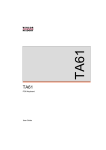
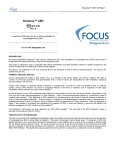
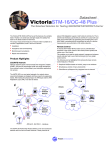

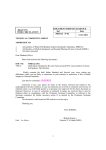
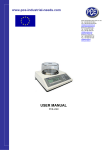
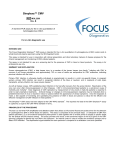
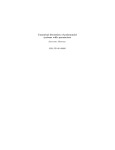
![[1]StorageTek Linear Tape File System, Open Edition](http://vs1.manualzilla.com/store/data/005641506_1-83def2383162ce3771fdbc891794971f-150x150.png)
